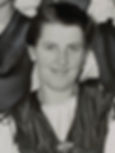Maria von Trapp, The Woman vs. the Myth
- N.J. Mastro
- Dec 14, 2024
- 4 min read
Every December Americans can watch The Sound of Music somewhere on television. How did this story of a family fleeing Austria to escape the Nazis become such a holiday staple?
The musical was never intended as a Christmas story, but one song seems to have placed it in this category. When Maria sings My Favorite Things, she mentions “snowflakes that stay on my nose and eyelashes,” “brown paper packages tied up with strings” and “silver white winters that melt into springs.” Such phrases sum up Christmas in the hearts of many.

If you're fan of the musical, then you'll probably enjoy reading Michelle Moran's new novel Maria, biofiction about Maria von Trapp published in 2024. I found it a fascinating read, one I'd highly recommend.
Maria opens as the musical by Rodgers & Hammerstein is in production in New York. It's 1959. The crew is frustrated with the actual Maria von Trapp's persistent interference. She doesn't like the script. It doesn't represent the truth, she says. But Maria has no say in the matter. Rodgers & Hammerstein had purchased the rights to produce a play based on Maria's life from a German company to whom Maria had sold her biography.
Maria, however, has never been one to take no for an answer and is determined to right things by speaking to Mr. Hammerstein himself. He, of course, has people for this kind of thing, and a woman on staff is sent to deal with Maria.
Enter Fran, administrative assistant. Through Fran Maria reveals her true story to readers, starting with her sad childhood to life in the convent, her eventual marriage to Baron von Trapp, and motherhood. Maria's life and character are not what or whom we know her as in The Sound of Music. The real Maria was quite different
The novel Maria is fiction, of course, allowing Michelle Moran to introduce fictional characters alongside actual individuals like Oscar Hammerstein, and she does so with adept handling. Moran is a seasoned biofiction writer with eight novels to her name. The result is a look below the surface of a woman Broadway and Hollywood created that reveals a courageous, determined woman who was not without her flaws.
The Real Maria Von Trapp

So who was the real Maria, the woman Julie Andrews played in the musical and, because of Rodgers & Hammerstein's Broadway phenomenon, the world has loved for more than 50 years? I won't say much, for to do so would spoil Moran's wonderful novel. Moran stays close to the facts.
The basic framework of The Sound of Music is true. Maria was recruited from a convent to serve as a tutor for the von Trapp family, but not for all of the children, only one who was ill at the time. In 1927, Maria married Georg von Trapp, the handsome baron 25 years her senior who had seven children, all of whom were good singers. The rest of Maria's story, however, departs quite significantly from the Broadway musical. Maria and Georg had three children of their own, and the family sang together for a decade before fleeing Austria and moving to to America when the Nazis took control of their homeland in 1938.

Then there's what happened to the von Trapp family when the period depicted in the musical ends. In America the von Trapps continued their singing career. In 1950 they bought and ran a lodge in Vermont they named The Trapp Family Lodge. Members of the von Trapp family still own and operate the resort. This link will take you to a list of family members and what happened to each of them.

The interesting thing is, Maria von Trapp wasn't part of promoting what has become a myth of her life because of The Sound of Music. She didn't pretend to be anyone but who she was. In fact, she did everything in her power to set the record straight before the musical came out. But whether on the stage or the big screen, what viewers see in a matter of hours can often distort reality.
The Sound of Music airs on Dec. 15, 2024, at 7 p.m. Eastern Standard Time. Personally, I can't wait to watch it again. I love every second of the musical no matter how many times I've seen it. The songs, the cinematography, the sizzle between Maria and the baron. It's all wonderful again and again.
After you see it, check out Maria. Your idea of Maria von Trapp won't be shattered, but you'll get to know Maria differently than what you know from the musical. Given her stalwart nature, the real Maria would want you to know the true story.
If you’d like to receive a copy of my next blog post featuring a review of a novel about a famous woman from the past, be sure to subscribe below.
I should mention it’s a good time to subscribe. From now until February when my debut novel Solitary Walker: A Novel of Mary Wollstonecraft is released, I’m holding monthly giveaways of some of my favorite historical biofiction novels to randomly selected subscribers.
Thanks for reading. I’m glad you’re here.
N.J. Mastro
Source for this post:
Gearin, Joan. "Movie vs. Reality: The Real Story of the Von Trapp Family." Prologue Magazine. The National Archives. Winter 2005, Vol 37, No. 4. https://www.archives.gov/publications/prologue/2005/winter/von-trapps-html